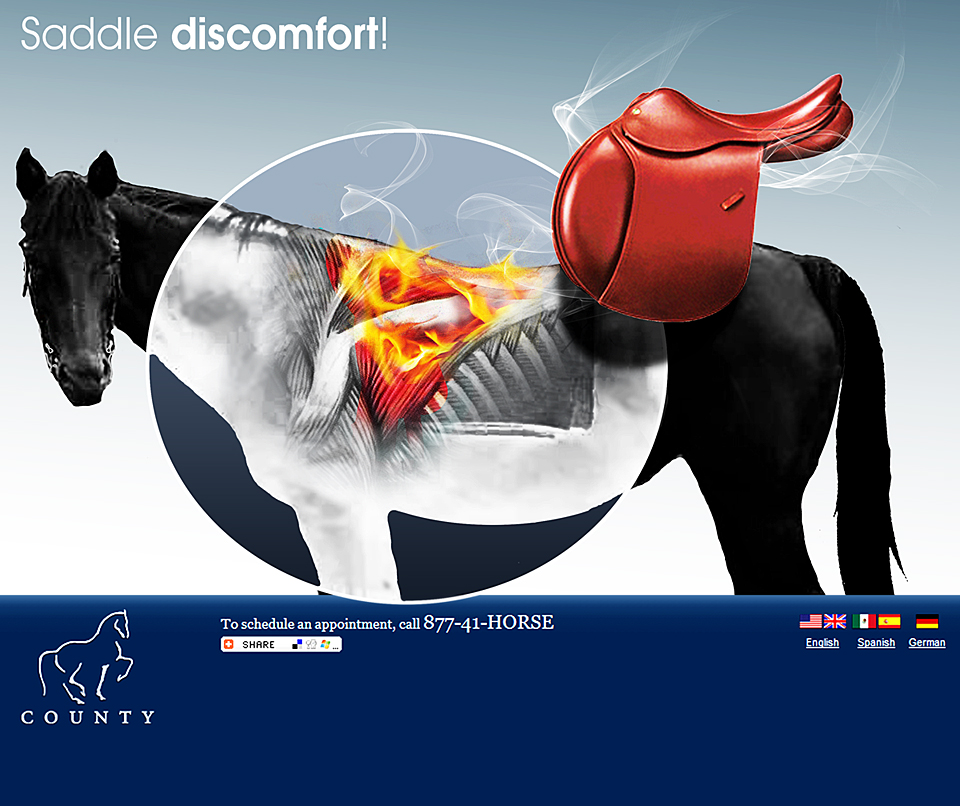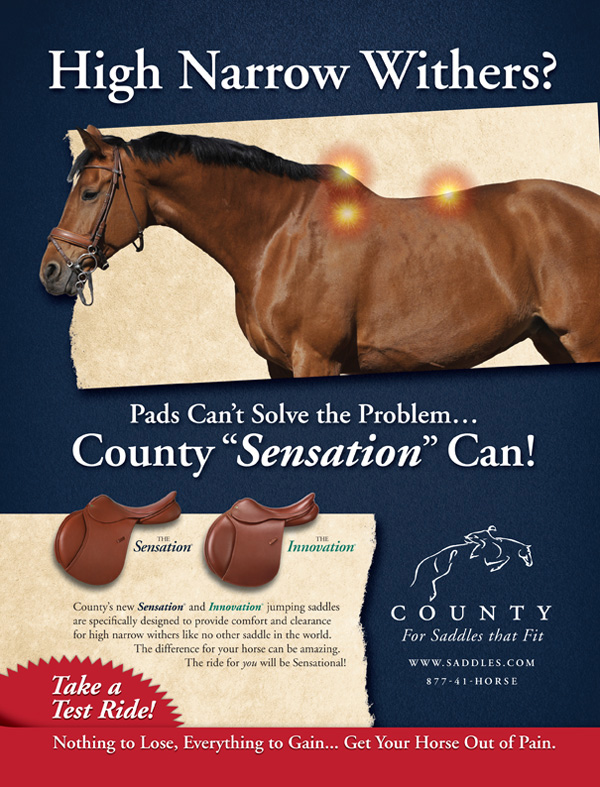Press

County Saddlery Solves Problem of Horse’s High Withers – Unsolved by Saddle Pads – with New Sensation Jumping Saddle
Horse Loses Pain, Rider Has Everything to Gain from Innovative Saddle DesignLisbon, Md
County Saddlery today announced its Sensation jumping saddle, touting its innovative design as the key to solving the frequently occurring problem of horses’ high withers, a problem riders often unsuccessfully attempt to address by using multiple saddle pads. Withers are the highest part of a horse's back, located at the base of the neck above the shoulders – the height of a horse is measured up to the withers. For jumping horses with high, narrow withers, saddles often are a painful, difficult fit, forcing riders to compensate by using extra saddle pads. But riders’ efforts to fix the high-withers problem with saddle pads are misguided, according to available research. County’ Saddlery’s new Sensation jumping saddle solves the high-withers problem with only one saddle pad. Along with County’s recently released Innovation saddle, Sensation is specifically designed to provide unmatched comfort and clearance for horses with high withers, according to the company, providing unprecedented pain relief for the horse and maximum performance for the rider.
County’s traditional methods take longer and require a higher degree of craftsmanship than competitors’ methods, but once a rider sits in a County, the results are clearly worth it. The company’s commitment to quality and detail is reflected in every saddle it makes. Resisting the trend toward cheaper production methods that use foam-rubber panels and plastic trees, County saddles are handmade on laminated beech-wood trees, covered in the world’s finest leather, and flocked with pure wool to maximize horses' comfort and fit. One of the few saddlery companies in the world to make their own tree points, County sets the industry standard in design and innovation. For more information, readers should visit County’s website at www.countysaddlery.com or call 1-877-41-HORSE. ###

County Saddlery Issues Report on Adjustable Tree-Point Saddle Problem New Testing Reveals that Spreading Saddle Trees can create serious problems Whether Spreading or Narrowing, Adjusting Trees Can Make Matters Worse County Saddlery today issued the following report detailing the saddle problem of adjustable tree points, finding that while an appealing concept, adjustable trees and adjusting trees often fail to solve existing saddle problems and can make matters worse: Adjustable Trees or Interchangeable Gullet Plates Because the shape of a narrow horse’s withers is different from the shape of medium-wide or extra-wide withers, simply replacing the head (front) of the tree with a wider version of the same shape does not solve the problem. For example, if a narrow horse’s withers are shaped somewhat like a triangle and a wider horse’s withers are more rounded, widening the triangle shape is no solution. The shape fails to conform to the withers’ shape, and often the result is rocking or uneven contact along the points and legs of the tree. The Problem with Spreading or Narrowing Tree Points Using a vice-like tool to open or close a tree can result in some of the problems previously described. Other problems that can occur are broken, weakened or uneven tree points. Spreading or narrowing the angle of the legs/bars of the tree can create a fulcrum at the base of the withers that can cause pressure and rocking. Changing the angles of the points and the legs of the tree after a tree has been finished with webbing and seated may also change the tension of that webbing and alter the feel of the seat. While adjustable trees and the practice of altering trees after they are made is an option for any manufacturer, many choose not to do it for the reasons previously cited. Other manufacturers may agree to do it, but the alterations may invalidate the warranty. A fulcrum may be created at the base of the withers, which can cause pressure and rocking. Horses change over time for many reasons, including change of season, training techniques and intensity, feed, injury and age. When a horse changes, the width of the tree is one factor of many to consider when fitting a saddle. A key point to remember: if the horse changes enough that the saddle needs changing, the old saddle still has significant value. Often, the difference between the value of a new saddle and the current saddle is little more than the cost of trying to adjust the tree and deal with the problems that may result. For more information on tree points and other saddle issues, readers should visit County Saddlery at Saddles.com ###

High Narrow Withers - County Saddlery Solves The Problem Pads Can't Solve The Problem - County Sensation Can! County’s new Sensation® and Innovation® jumping saddles are specifically designed to provide comfort and clearance for high narrow withers like no other saddle in the world. The difference for your horse can be amazing. The ride for you will be Sensational! County Saddlery Identifies The Problem with Spreading or Narrowing Saddle Tree Points Although an appealing concept, adjustable trees and adjusting trees may not solve your problem, and may actually create some new ones. Here are some things to consider: • Adjustable Trees or Interchangeable Gullet Plates Because the shape of a narrow horses withers is very different than the shape of a medium, wide, or extra wide withers, simply replacing the head (front) of the tree with a wider version of the same shape does not solve the problem. For example, if a narrow horse’s withers are shaped somewhat like a triangle and a wider horse’s withers are more rounded, simply widening the triangle shape is no solution. Not only does the shape not conform to the withers shape, but the result is often rocking or uneven contact along the points and legs of the tree. • The Problem with Spreading or Narrowing Saddle Tree Points Using a vice-like tool to open or close a tree can result in some of the problems previously described. Other problems that can occur are broken, weakened, or uneven tree points. Spreading or narrowing the angle of the legs/bars of the tree can create a fulcrum at the base of the withers which can cause pressure and rocking. Changing the angles of the points and the legs of the tree after a tree has been finished with webbing and seated may also change the tension of that webbing and alter the feel of the seat. While adjustable trees and the practice of altering trees after they are made is an option for any manufacturer, many choose not to do it for the negative reasons cited here. Other manufacturers may agree to do it, but the alterations may invalidate the warranty. A fulcrum may be created at the base of the withers which can cause pressure and rocking.Horses change over time for many reasons. Change of season, training techniques and intensity, feed, injury, and age are just a few of the variables. When a horse changes, the width of the tree is only one of many factors to consider when fitting a saddle. Remember, if your horse changes enough that you need to change saddles, your old saddle still has significant value. Often times, the difference between the value of a new saddle and your current saddle is little more than the cost of trying to adjust the tree and deal with the problems that may result. CountySaddlery.com 1- 877 - 41- HORSE
